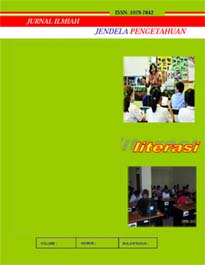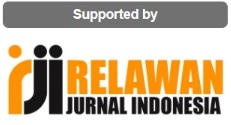Geosphere Phenomena from a Geographical Perspective: Examination of Substance and Complexity
Fenomena Geosfer dalam Perspektif Geografi Telaah Substansi dan Kompleksitas
Abstract
In the study of geography, the complexity studied covers a broad aspect of various geosphere phenomena with a unique approach as a geographical identity in examining every problem spread across the earth. The approach referred to as an analytical tool in assessing geographic reality includes spatial, ecological, and complex regional approaches. From this approach, geographers can examine various realities on earth more comprehensively by referring to the multiple problems in each region and simultaneously being a differentiator with various other sciences. From a geographical perspective, the geosphere phenomenon is analyzed based on the regional landscape as a causative factor. The underlying physical conditions are accompanied by various human activities that indirectly change nature so that the area experiences multiple damages. Spatially and ecologically, various damages can be mapped, emphasizing human interaction with nature. Then, it is thoroughly studied in a complex area so that an understanding of the causes of flooding and solutions that can be put forward can be realized more specifically. It is the geography specification that contributes ideas for advancing science and knowledge.
Downloads
References
Aksa, F. I., Utaya, S., & Bachri, S. (2019). Geografi dalam perspektif filsafat ilmu. Majalah Geografi Indonesia, 33(1), 37–43. https://doi.org/10.22146/mgi.35682
Astawa, I. B. M. (2016). Understanding The Dynamics In Development Philosophy Foundation Geography. Jurnal Ilmiah Ilmu Sosial, 2(1). https://doi.org/10.23887/jiis.
Bednarz, S. W. (2004). US world geography textbooks: Their role in education reform. International Research in Geographical & Environmental Education, 13(3), 223–238. https://doi.org/https://doi.org/10.1080/10382040408668517
Bintarto, & Hadisumarno. (1978). Metode Analisa Geografi. LP3ES Jakarta.
Bintarto, R. (1968). Buku penuntun geografi-sosial. UP" Spring".
Bintarto, R. (1991). Geografi Konsep dan Pemikiran. Fakultas Geografi UGM. Yogyakarta.
Bowerman, B. (2001). Geography world.
Broek, J. O. M. (1965). Geography: Its scope and spirit. CE Merrill Books.
Chang, C.-H., & Pascua, L. (2016). Singapore students’ misconceptions of climate change. International Research in Geographical and Environmental Education, 25(1), 84–96. https://doi.org/https://doi.org/10.1080/10382046.2015.1106206
Danardono, S. S., & Fikriyah, V. N. (2021). Sistem Informasi Geografis dan Aplikasinya di Bidang Geografi. Muhammadiyah University Press.
Dickinson, R. E. (1969). The makers of modern geography. Praeger.
Effendi, R., & Akmal, H. (2020). Geografi dan Ilmu Sejarah: Deskripsi Geohistori untuk Ilmu Bantu Sejarah. Program Studi Pendidikan Sejarah FKIP Universitas Lambung Mangkurat. https://repo-dosen.ulm.ac.id/handle/123456789/18445
Gersmehl, P. J., & Gersmehl, C. A. (2007). Spatial thinking by young children: Neurologic evidence for early development and “educability.” Journal of Geography, 106(5), 181–191. https://doi.org/https://doi.org/10.1080/00221340701809108
Haggett, P. (1983). Geography a Modern Synthesis, Nueva York. Harper Collins Publishers.
Hartono, T. H. P. (2018). Penginderaan Jauh Dan Sistem Informasi Geografi Untuk Pengelolaan Potensi Sumberdaya Lokal Dan Pembelajaran Geografi. Prosiding, 3.
Hartshorne, R. (1960). Political geography in the modern world. Journal of Conflict Resolution, 4(1), 52–66. https://doi.org/https://doi.org/10.1177/002200276000400104
Hastuti, H. (2009). Perspektif Spatial Dalam Kajian Geografi Manusia. Geo Media: Majalah Ilmiah Dan Informasi Kegeografian, 7(2). https://doi.org/https://doi.org/10.21831/gm.v7i2.19087
Holt-Jensen, A. (2003). Achievements of spatial science. In Companion Encyclopedia of Geography (pp. 846–864). Routledge.
Kavouras, M. (2000). Understanding and modelling spatial change. In Life and Motion of Socio-Economic Units (pp. 57–67). CRC Press. https://www.taylorfrancis.com/chapters/edit/10.1201/9781482268096-11/understanding-modelling-spatial-change-marinos-kavouras
Kurniasi, A. S., Zid, M., & Sya, A. (2022). Epistemologi dalam Pembelajaran Geografi. Edumaspul: Jurnal Pendidikan, 6(1), 139–144. https://doi.org/https://doi.org/10.33487/edumaspul.v6i1.2737
Lasaiba, M. A. (2006). Evaluasi lahan untuk permukiman dalam pengembangan wilayah Kota Ambon. Tesis. http://etd.repository.ugm.ac.id/penelitian/detail/31752
Lasaiba, M. A. (2012). Perubahan penggunaan lahan di Kota Ambon Tahun 2002-2009. Disertasi. http://etd.repository.ugm.ac.id/penelitian/detail/54572
Lasaiba, M. A. (2013). Kajian Keruangan Penggunaan Lahan Dalam Pengembangan Kota Ambon Berbasis Ekologi. Jurnal Pendidikan Geografi UNESA, 11(21), 34–56.
Lasaiba, M. A. (2016). Dimensi Spasial Karakteristik Sebaran Dan Deviasi Pola Pegunungan Lahan Terhadap Ekosistem Pesisir Di Kota Ambon. Jendela Pengetahuan, 9(1), 24–34.
Lasaiba, M. A. (2018). Penggunaan Model Pembelajaran Berbasis Masalah (Problem Based Learning) Terhadap Hasil Belajar Geografi Pada Peserta Didik Kelas Vii-2 Smp Negeri 14 Ambon. Jendela Pengetahuan, 11(2), 8–21. https://ojs3.unpatti.ac.id/index.php/jp/article/view/6317
Lee, J., & Bednarz, R. (2012). Components of spatial thinking: Evidence from a spatial thinking ability test. Journal of Geography, 111(1), 15–26. https://doi.org/https://doi.org/10.1080/00221341.2011.583262
Mitchell, J. T., Borden, K. A., & Schmidtlein, M. C. (2008). Teaching hazards geography and geographic information systems: A middle school level experience. International Research in Geographical and Environmental Education, 17(2), 170–188. https://doi.org/https://doi.org/10.1080/10382040802148679
Morrill, R. L. (1970). The spatial organization of society. Wadsworth Publishing Company.
Nugroho, A. R., & Hastuti, K. P. (2013). Konsep Geografi Dalam Pendidikan IPS. Mewacanakan Pendidikan IPS, 115. http://eprints.ulm.ac.id/
Rijanta, R. (2006). Ruang Dan Tempat Dalam Studi Pemekaran Perspektif Teori Dan Pengalaman Empirik Kabupaten Kutai. Majalah Geografi Indonesia, 20(2), 114–136. https://doi.org/https://doi.org/10.22146/mgi.13302
Salsabila, A., & Kristianawati, A. D. (2021). Laporan Penelitian “Hidrologi Kawasan Karst Gunung Sewu Di Kecamatan Tanjung Sari Kabupaten Gunung Kidul Yogyakarta.”
Sholeh, M. (2019). Rekonstruksi Pembelajaran Kebencanaan Pada Mata Pelajaran Geografi. https://doi.org/10.31227/osf.io/9akvy
Sprenger, S., & Nienaber, B. (2018). (Education for) Sustainable Development in Geography Education: review and outlook from a perspective of Germany. Journal of Geography in Higher Education, 42(2), 157–173. https://doi.org/https://doi.org/10.1080/03098265.2017.1379057
Stilwell, F. (1992). Understanding Cities and Regions: Spatial. Political Economy (Pluto Press, Leichhardt, Sydney).
Strahler, A. H., & Strahler, A. N. (2006). Introducing physical geography (Issue Sirsi) i9780471679509).
Suharsono, S., & Budi, T. P. (2006). Penajaman Dan Kejelasan Objek Kajian Dalam Disiplin Ilmu Geografi. Majalah Geografi Indonesia, 20(2), 187–201. https://doi.org/https://doi.org/10.22146/mgi.13306
Suharyono, & Moch Amin. (1994). Amien. 1994. In Pengantar Filsafat Geogarafi.
Sukmawati, U. S., & Susilo, S. (2015). Kearifan lokal masyarakat adat dalam pelestarian hutan sebagai sumber belajar geografi. Jurnal Pendidikan Humaniora, 3(3), 202–208.
Sumaatmadja, N. (1988). Studi geografi: suatu pendekatan dan analisa keruangan. Alumni.
Sumaatmadja, N. (1997). Metodologi pengajaran geografi. Jakarta: Bumi Aksara.
Treman, I. W. (2011). Substansi Pembelajaran Geografi Di Era Globalisasi. Media Komunikasi FPIPS, 10(1). https://doi.org/https://doi.org/10.23887/mkfis.v10i1.1172
Uhlenwinkel, A., Béneker, T., Bladh, G., Tani, S., & Lambert, D. (2017). GeoCapabilities and curriculum leadership: balancing the priorities of aim-based and knowledge-led curriculum thinking in schools. International Research in Geographical and Environmental Education, 26(4), 327–341. https://doi.org/https://doi.org/10.1080/10382046.2016.1262603
Yani, A., & Rahmat, M. (2007). Geografi: Menyingkap Fenomena Geosfer. PT Grafindo Media Pratama.
Yunus, H. S. (1994). Teori dan Model Struktur Keruangan Kota. Yogyakarta: Fakultas Geografi UGM Yogyakarta.
Yunus, H. S. (2008). Dinamika wilayah peri-urban: determinan masa depan kota. Pustaka Pelajar.
















